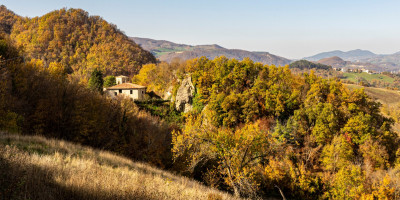Rocca di Crovara – 460 mslm
I ruderi della rocca di Crovara sono situati sulla sommità di uno sperone roccioso di arenaria, con fianchi ripidi e strapiombanti, quindi una collocazione con forte vocazione difensiva.
Alcune parti architettoniche sono attribuibili alla piena età medievale, mentre altre vennero probabilmente aggiunte in epoca “basso” medievale.
Pur mancando documenti precisi sull’anno di fondazione è ben noto e documentato che esso è strettamente legato alla storica famiglia dei Da Palude, feudatari di Crovara investiti nel 1188 della carica dall’imperatore Federico Barbarossa.
La storia successiva del castello, con i vari assedi fino alla pressoché totale distruzione, è quindi indissolubilmente legata alle sorti di questo casato, di probabili origini longobarde, poi legata nel 1200 alla fazione dei Ghibellini e coinvolta in azioni di brigantaggio, così da spingere le milizie congiunte dei Comuni di Reggio e di Parma all’ennesimo assedio della rocca, che venne infine rasa al suolo nel 1272.
La rocca venne poi parzialmente riedificata in epoche successive fino alla definitiva rovina, cui contribuì l’utilizzo di sue parti come materiale di costruzione delle abitazioni rurali circostanti.
La rocca è comunque tuttora oggetto di campagne di scavi archeologici, che hanno già permesso di mettere in luce parti della struttura originaria e di recuperare vari reperti.
Ai piedi dello sperone roccioso si trova la chiesa, che risale al XVII sec., epoca in cui venne innalzata sempre per iniziativa dei conti Da Palude. All’interno della chiesa, recentemente restaurata, si conservano importanti opere d’arte, tra cui un’Annunciazione e una Madonna del Rosario recante la dedicazione dei Da Palude.

